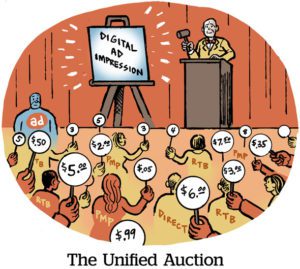The open web can be a scary place for brands. The targeting signals they once relied on are disappearing, and they’re wasting a ton of money on made-for-advertising sites.
Instead of casting their net across the entire internet, some marketers are matching their own data to publisher data sets on the open web.
Then, they buy only within curated private marketplaces (PMPs).
This type of deal curation traditionally took place at the DSP level, but it’s increasingly offered by curation vendors, data management platforms (DMPs) and retail media networks (RMNs).
SSPs are also gravitating to curation as a way to stand out, including Index Exchange.
The SSP announced today it’s launching a new product, Index Marketplaces, that activates the curation capabilities of DSPs, DMPs and RMNs – and the demand for their PMP deals – across its network of publishers.
The idea is to use the company’s existing integrations to enable what CEO Andrew Casale called “frictionless” data matching along with new demand for publishers.
Infrastructure costs
Historically, ad tech companies have invested considerable time and money into creating connections with DSPs, data partners and publishers.
“If you wanted to do this on your own, you’d have to connect to 2,000 publishers and be able to handle half a trillion requests a day,” he said.
But that approach isn’t cost effective for deal curation because the goal is to apply data to reach the small subset of users that would be most receptive to a brand’s message, he added.
So rather than data matching tech vendors building a lot of pipes that money was never going to flow through, they can use Index’s preexisting infrastructure. Index manages the deal IDs that identify these audiences and runs the ad auctions, and its data partners focus on matching data sets to create audiences for PMP deals.
Index is also only charging its standard publisher fee, without any additional upstream fee charged to the curator, unlike other SSPs, Casale said.
To be fair, it’s much more expensive for an SSP like Index to process transactions on curated inventory, Casale said. So it makes sense that other SSPs charge their curation partners a fee. But this approach has incentivized curation vendors to bypass those fees by working directly with publishers. Then, those same companies end up competing with SSPs.
Casale believes Index’s approach is more efficient, and the company is making a long-term bet that its strategy will pay off as the SSP market continues to consolidate.
Meanwhile, on the sell side, the publishers themselves don’t have to make any additional integrations or change their code to enable curation.
And Index is keeping DSPs as part of its supply chain – another break with SSP competitors like PubMatic and Magnite, which have both recently launched buy-side direct products that cut out DSPs in certain cases. Index Marketplaces is DSP-agnostic, meaning it allows advertisers to activate PMP deals through their DSP of choice.
Working with DSPs on curation is important, because the DSP has a better idea of the marketer’s goals and can optimize accordingly, Casale said. But doing all the curation on the buy side could result in leaving some impressions on the table, because the matches against publisher inventory won’t be as strong, he added.
However, Marketplaces doesn’t play nice with everyone. The solution is not compatible with other SSPs, because it relies on Index’s direct connections to publishers.
Better performance, more demand
Marketplaces has been in closed beta since September, during which Index tested the solution with six tech partners. It has since expanded that roster to ten launch partners, including Audigent, AdChat, Adelaide, Integral Ad Science (IAS), IRIS.TV, JW Player, LiveRamp, Multilocal, Reklaim and SWYM.ai. Agency launch partners include Omnicom Media Group UK and Dentsu Japan.
The LiveRamp connection is especially important for activating data sets from retail media networks, since many of them build their data graphs using its RampID.
And it made sense for Audigent to participate, said CEO Drew Stein, because Index is the SSP most frequently requested by brand and agency clients.
Plus, in early testing, Index’s solution enabled Audigent to hit its clients’ KPIs more quickly and efficiently compared to similar SSP offerings, Stein said.
For example, sometimes campaigns for banking or insurance clients can get lost in the mix of deals on other SSPs. Audigent has to manually ensure those SSPs are prioritizing those campaigns, Stein said. Index’s platform seems to intuitively prioritize campaigns that require more attention and scale, which allows them to ramp up more quickly and perform better for advertisers, he said. That trickles down to publishers, which get more demand via these curated connections.
From Casale’s view, the demand for curated inventory is strong: Marketplaces is already the fastest-growing product Index has ever introduced, he said.
In the four-month testing period, it scaled up to a $100 million run rate across six partners. In contrast, Index’s previous fastest-growing product – its streaming TV offering – took about two years to scale up to the same run rate, Casale said.
Index does not currently have a concrete timeline in place for general availability, but it has been in conversation with 100 potential partners about joining the program, Casale said. However, it wants to add partners slowly to ensure there won’t be any operational burdens that prevent new clients from creating and scaling curated audiences.
Ultimately, Casale said, Index doesn’t want to rush a solution that could evolve programmatic from a play of reaching all of the open web to an approach emphasizing curation from the open web.



















